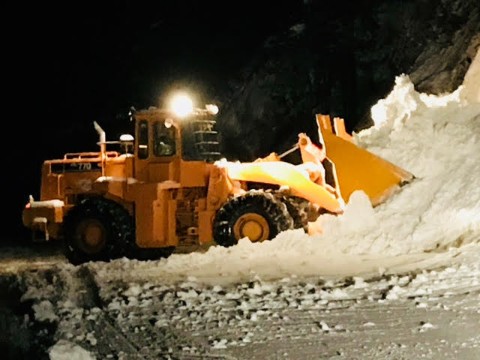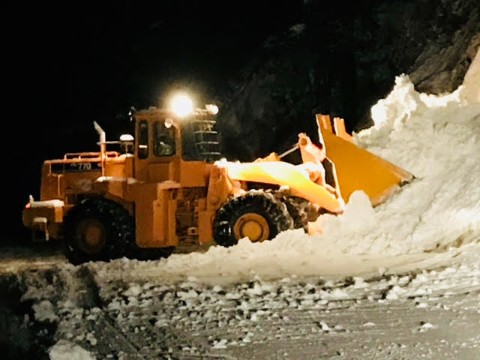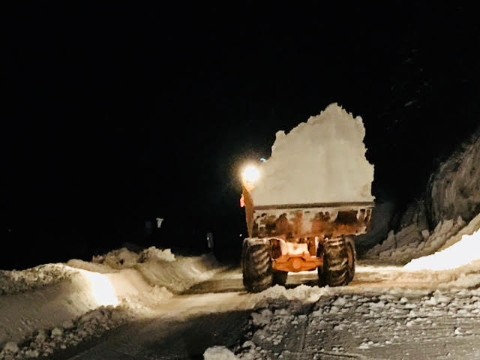Throughout the winter months the highway becomes dicey and icy as the road narrows to a thin two-track lane where a slim piece of asphalt can be seen. When the powder surrounds, the tension can rise and the slides come down.
For most of us, our main concern is our own safety. Of course, nobody likes to hear of anyone injured or worse, it is in our nature to be concerned and care for our fellow neighbour, but when we hit the highway it can feel like every driver for themselves.
It takes a round the clock crew to make sure the highway out of town is as clear as can be. Emcon Services in Revelstoke have a crew running 24/7- 7 days a week. While they continue with road maintenance throughout the year, they gear up for snow removal November 1st and wrap it up sometime near the end of March depending on the weather.
Whenever we see an alert for a massive snow dump everyone has to consider their daily routine and whether or not they can accomplish their tasks- especially if their task means driving the highway.
Gabe Nava Lander from Emcon sat down with the Revelstoke Current to give a detailed breakdown of what happens on the highway and why certain tasks happen before others.
“Closing a highway is easy. It takes one call. Opening a highway is very hard to get it open and to get the traffic moving safely.”
Over the holidays Revelstoke and the surrounding area had a massive snow fall between December 27th-30th. Emcon managed to keep the roads bare because of this relatively new anti-icing they use. Between this and 9-12 employees working around the clock, they were able to keep traffic moving.
Those that utilize Highway 23 North and Highway 23 South may wonder why does it appear that these two stretches of road not receive the same attention as the pass. the TCH is classified as a Class-A road while Highway 23 N/S is classified as Class-B; which does affect how and when they plow it.
“Staff will be working from 3:00am just to make sure that (highway) 23-South is clear all the way to the ferry. We have a camp at Mica, there is a crew that start their day at 2:30am to clear (highway) 23-North all the way to the meeting point to keep the loggers moving.” Nava Lander explained.
When it comes to snow removal, it can only be removed once it has fallen. Naturally, we want to see the roads bare from the time it starts snowing until it stops, however, a Class-A highway can have a maximum of 4cm of snow on it before removal has to happen, but Emcon has the 24/7- 7 rule to make sure that they keep up with the falling snow.
“You could be plowing to Albert Canyon, and by the time you hit the point, 2cm has fallen behind you. It is a constant cycle, but these trucks never stop.”
Every piece of equipment that Emcon uses is serviced every 5000km, that includes all service vehicles, tandem trucks and the plows.
When asked about the smaller moving vehicles and the danger they put themselves into, 31 year veteran, Derek Thur shared his experience and what he has seen impatient drivers do.
“I think this is one of the most dangerous areas to maintain, yet people still pass on the right hand side and follow too closely- those are the main two things people continue to do time and time again. The drivers (of the plow) know you want to get around them. They will pull over to the side when they feel it is safe. Remember, if you pass a plow you are passing into a dangerous zone. That’s why the plow is out to begin with.”
Accidents happen all along this stretch of road, this is no secret. Many of the accidents are due a combination of speed, impatience and black ice. There have been some positive changes within highway maintenance. In fact, the anti-icing that is being used to help clear the roads has been well received by the federal Transportation Department. They are quite please with the Revelstoke crew as they are keeping the roads bare, even at -18, which is rare.
The anti-icing product is anti-corrosive and friendlier to vehicles and more importantly, to the earth. This mix is used prior too, during and after heavy storms roll through. One note about this particular product is that it can make the road appear darker than it actually is.
“The colour of the road will change, but it does not mean it is black ice, it just appears that way. Again, that does not mean people should be ignoring the speed limits, they too, are set for a reason.”
With smaller moving vehicles on the road risking themselves and taking chances, what are the transport drivers doing to add to that risk? Many accidents occur between two massive semi-trucks with no smaller vehicle insight. Nava Lander spoke to this matter, and in his opinion many accidents he has seen are due to inexperienced drivers.
“I have seen many accidents on this highway, and many of them are individuals that have recently immigrated to Canada to start a better life, which is fantastic, I immigrated myself many years ago, so I understand the sensitivity behind this issue, but there needs to be better training system in place for commercial drivers. Many newcomers are eager to work, but they are simply not trained to drive these treacherous mountain passes. Driving in the lower mainland is very different. I have seen a 60-thousand pound semi with no chains on, the driver had no idea how to put them on. That is the guy who could kill someone.”
Come the spring, the snow plows will retire for the season and crews will begin regular highway maintenance. From rock slide removal to fixing the drain system at the intersection of the TCH and Highway 23-South- Emcon is working the road.








